|
| STEPS OF THE PASSION |
Page traduced by Fernando P. de Oliveira. |
|
| There are images narrating Jesus Christ's Via Crucis in the six chapels located below the Basilica Church. In these chapels are 66 sculptures in cedar, created by Aleijadinho (The Cripple One) and his assistants, between August 1, 1796 and December 31, 1799. |
| STEP OF THE SUPPER |
| Located at the bottom of the ramp, it is the largest of the chapels as well as the oldest of the whole complex. It depicts Jesus' Holy Supper with His aplostles and two servants; more specifically it shows the very moment when Jesus says " In truth I tell you that one of you will betray me", the apostles appearing disturbed. All pieces are close to life size, most of them made out of one single block of wood except for the hands, which are movable. The only finished sculptures are the two servants and the first four apostles, more visible.The remaining ones, half bodied, are leaning on supports behind the round table.. | 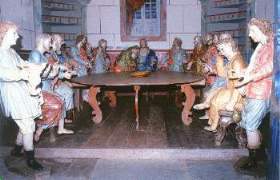 |
| STEP OF THE GARDEN |
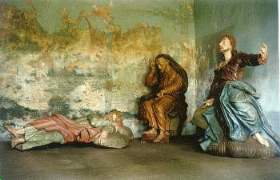 |
To the left of the ramp and at a short distance
from the Supper is the chapel showing Jesus' agony and prayer in the Garden of the Olives,
initial milestone of the Passion. The figure of an angel, hanging on top of the chapel,
holds in his right hand a chalice that represents the gall that must be
drunk:"Father, if it pleases You, turn this chalice away from me." The angel used to hold a cross in his left hand, but it has been removed since 1957 in order to better protect the statue. The images, in perfect finish and excellent workmanship thus form a harmonious set composed by the angel, Jesus sitting in prayer, plus the apostles Peter, James and John, asleep. |
| STEP OF THE IMPRISONMENT |
| It is at the right hand side of the chapel of the Supper. Eight characters make up this group: Jesus, Peter, Malco, Jude and four guards. In an instinctive move of defense for the Master, Saint Peter cuts off the guard Malco's ear. Christ calms Peter down and walks towards the injured man in order to heal him. At this exact moment in the scene Christ has Malco's ear in His hand. This set of images is the most homogeneous of all, by far. The figures are made in excess of 2 meters tall. | 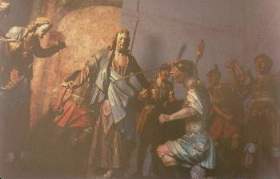 |
| STEP OF THE SCOURGING AND THE THORNS CROWNING |
The works were halted for near half a century
after completion if the chapel of the imprisonment. Construction of the Chapel of the
Scourging and the Thorns Crowning began in 1864. The decision to build only 6 chapels
instead of the planned 7 was made at that time.Thus, this chapel stores only two steps.
Some say that building only six chapels had to do with the Crippled One's superstition
regarding the number 7. However, this cannot be farther from the truth, since the chapels
were erected years after his death. Both scenes are independent from each other, separated
by a wood beam. The lack of room gives an impression of disorder and confusion.
|
| STEP OF ASCENDING TO CALVARY |
| Built between 1867 and 1875. Depicts Jesus' ascent to Calvary, carrying the cross on his back, Aleijadinho (The Crippled One) chose the episode "meeting with the daughters of Jerusalem" as narrated by Saint Luke. In this scene one finds two instances of image transferring: a boy with a carnation in his hand, transferred in the restoration of 1957 from the crucifixion chapel and one of the figures of a guard, easily identified by similar polycrony to the guards in the scourging. Originally 9 images, with the transferring becoming 11. The only figures of said group entirely attributable to Aleijadinho (the Crippled One) is Christ's and the woman drying tears. |  |
| STEP OF THE CRUCIFIXION |
 |
The last chapel is made of 11 images, split into three points of interest.At the center, the figure of two executioners nailing Christ to the cross and Magdalene weeping. At Christ's left hand side two guards throw dice, gambling for Christ's robe.At His right hand side two thieves with tied hands.Three other guard figures watch the scene, one being different due to his clothing. Mary Magdalene's image was projected to be seen from a profile angle totally chiseled at one side and roughly finished at the other. |
 |
The Rosary Church The Rosary Church (photo) is the oldest in town, built by slaves towards the end of the XVII Century, before the arrival of the first miners in the area. It keeps the simplicity of that time to this very day. |
Cathedral of our Lady of the ConceptionThis church has the facade made by the Crippled One and paintings by the best "Mineiros" artists of the epoch, It became a church in November 6, 1749. The facade was built in a Jesuit style XVIII, having two front towers with volute and bells thrush connected to the church, proper. The Cathedral nave is one of the largest in Minas, forming a single unit, with no hallway. The main altar houses the image of the patroness, Our Lady of the Conception. |
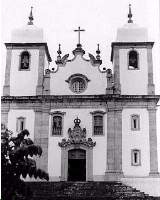 |
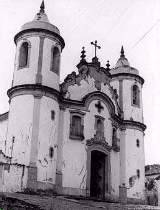 |
Saint Joseph's Church Rich in its sculptures, Saint Joseph's Church was built in 1817. In the main altar, an image of Saint Joseph's. The church is located at a street bearing the name of the saint and it leads to the Basilica Church. Mentioned street, made by slaves, can only be traveled on foot due to the enormous stones which serve as its pavement. |
Church of Our Lady of HelpLocated in the District of High Maranhao, this church was built in 1746. The main altar used to be home to a historic image of Our Lady of Help until a few years ago. The original image was stolen and has been replaced recently but the current image, in comparison with the first one, possess no historic value. This kind of crime has become too frequent in historic cities, affecting not only the cultural heritage of the place but also the heart of the faithful. |
|
|